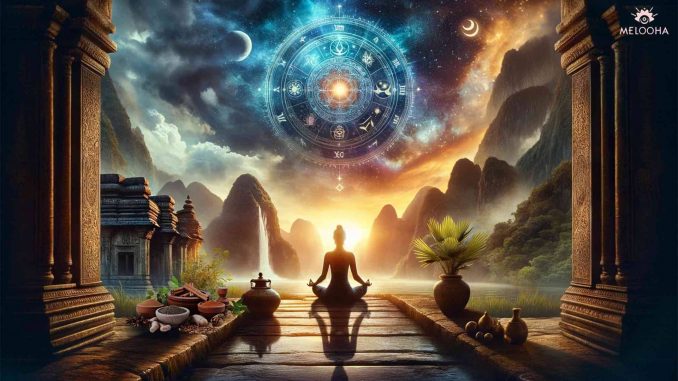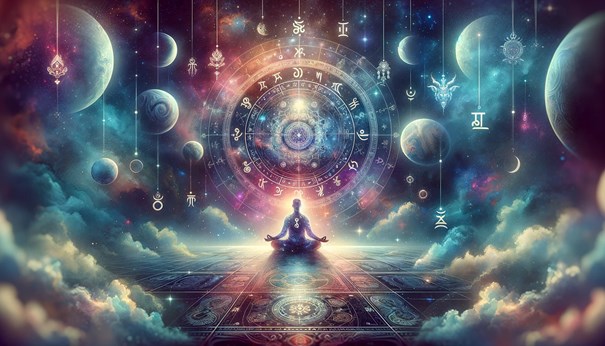
In the ancient tapestry of human culture, astrology has woven a intricate and enchanting narrative, intertwining the movements of celestial bodies with the rhythms of human life. An astrological reflection ritual is a profound practice that harnesses the wisdom of the stars, utilizing the cosmic tapestry to guide meditation and inner exploration. This article delves into the fundamental concepts and historical backdrop of astrological rituals, offers insights on crafting personalized meditations aligned with lunar phases and planetary retrogrades, and provides practical steps to facilitate self-reflection.
The Basics and Historical Context of Astrological Rituals
Astrology, rooted in ancient civilizations such as Egypt, Babylon, and Greece, views the universe as a harmonious symphony where the positions and movements of stars, planets, and other celestial phenomena influence human affairs. Early practitioners believed that by understanding these cosmic patterns, they could divine the future, guide decision-making, and even heal.
Astrological rituals have evolved from these foundational ideas, incorporating elements of mysticism, religion, and personal development. These rituals often involve observing specific celestial events, such as eclipses, solar ingressions into new zodiac signs, or planetary retrogrades, to synchronize one’s inner state with the broader cosmic forces. By doing so, individuals aim to gain clarity, find balance, and deepen their connection to the universe.

Designing Personal Meditations Based on Celestial Phenomena
1. Lunar Phases:
The moon’s cycle, from new moon to full moon and back, offers a natural template for setting intentions, releasing, and reflecting.
- New Moon: A time for planting seeds of intention. Spend time in meditation visualizing your goals and desires, using the new moon’s energy to empower your aspirations.
- Waxing Moon: As the moon grows, so should your efforts towards your intentions. Use this phase to take actionable steps and manifest your desires.
- Full Moon: A peak moment for release and gratitude. Meditate on what you wish to let go of, perhaps through journaling or a ritual burning ceremony.
- Waning Moon: The moon’s decrease invites introspection and letting go. Reflect on the cycle, acknowledging what has been learned and released.
2. Planetary Retrogrades:
Retrogrades, when planets appear to move backward in the sky, are periods of reflection and reassessment. Each planet’s retrograde offers unique insights:
- Mercury Retrograde: Focus on communication, travel plans, and past relationships. Meditate on clarity and patience, reevaluating recent decisions.
- Venus Retrograde: A time to reassess values, love, and finances. Use this period to heal old wounds and cultivate self-love.
- Mars Retrograde: Examine your motivations, assertiveness, and energy levels. Meditate on inner strength and strategic planning.

Practical Steps and Tips for Self-Reflection
Step 1: Preparation
Choose a quiet, comfortable space free from distractions. Set the mood with candles, incense, or soothing music if it aids your concentration.
Step 2: Centering
Begin with deep breathing exercises or a brief guided meditation to center your mind and body. Acknowledge your presence and intention for the ritual.
Step 3: Observing the Celestial Event
If possible, observe the specific celestial event (e.g., the new moon rising, a planetary retrograde in the night sky) as part of your ritual. This can be done outdoors or through astronomical apps if viewing isn’t feasible.
Step 4: Reflective Meditation
Guided by the celestial phenomena, delve into a reflective meditation. Allow thoughts to flow naturally, focusing on areas related to the celestial event. For instance, during a Venus retrograde, explore questions about love, beauty, and self-worth.
Step 5: Journaling
After meditation, jot down your insights, feelings, and any revelations in a journal. This step solidifies your learning and provides a record for future reflection.
Step 6: Closing
End your ritual with a sense of gratitude, expressing thanks to the universe for the guidance received. Slowly bring your awareness back to the present moment, feeling grounded and centered.
Conclusion
An astrological reflection ritual is a bridge between the vast cosmos and the intimate landscape of the human soul. By aligning our inner journeys with the rhythmic dance of the stars, we can tap into a deeper well of wisdom and self-understanding. Whether through lunar phases or planetary retrogrades, these practices offer a timeless path to meditation, introspection, and personal growth. Embrace the celestial guideposts, and let the universe illuminate your inner journey.

Leave a Reply